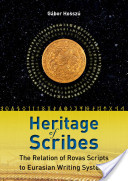
Heritage of Scribes:
The Relation of Rovas Scripts to Eurasian Writing Systems
Rovas Foundation, Budapest, 2013, ISBN 978 96 38 84 3746
Google Books
© Copyright 2011-2014 by Dr. Gábor Hosszú and Rovas Foundation
Preview

| Runic Writing | ||
 |
Gábor Hosszú Heritage of Scribes: The Relation of Rovas Scripts to Eurasian Writing Systems Rovas Foundation, Budapest, 2013, ISBN 978 96 38 84 3746 Google Books © Copyright 2011-2014 by Dr. Gábor Hosszú and Rovas Foundation Preview |
 |
|
Links |
|
http://nimrud.eet.bme.hu/hosszu/ Home page, Bio I. Kyzlasov Turkic Alphabets S. Baichorov Ancient Türkic Runic Monuments of Europe (Alphabet Table, Bulgar Morphology) Ivik, Kluchnikov Khazars PDF preview |
|
Posting Introduction |
The work of Dr. Gábor Hosszú Heritage of Scribes not only attracted attention, it attracted attention as the first and only systematic study of the Eurasian runiform scripts. This first comprehensive scientific work made a great stride to uncover genealogy, development, and history using glyph analysis programming tools. As a source of our past, the runiform material still does not exist other than anecdotal evidence pertaining to dispersed subjects. Since the early Middle Ages, the European runiform texts were associated with hated old religions slated for eradication along with their Satanic paraphernalia. The holy fathers, some of them literate, were the best experts on holiness and satanism. The scripts, attested for more than a millennium, were turned into hostile markings, assigned satanic magical powers or magical use destined for oblivion, and replaced with phony surrogates. Ironically, the actors who were pursuing the devil's scripts sunk into oblivion, their names are not known, and their grisly achievements not sung. Probably, the runiform scripts are the last dissipating vestiges of the European Dark Ages, they buoy in the scientific circles, rise to the popular attention, and gain deserved historical standing. Any reader will be impressed with the depth of the research work, the transparency of logics, and the scope and clarity of the results. These achievements are crowned with a comprehensive Glyph Atlas (Rovas Atlas) that portrays genealogy of each letter. The Minimum Entropy Method, widely used as a research tool in genetics and other disciplines, breaks the path to at times imperceptible correlations, which, in turn, allows to decipher problematic inscriptions. To accomplish the mammoth task, an enormous preparatory work had to be conducted, to gather, study, and systematize dispersed details of very unequal quality in a mountain of mostly obscure literature, a project that is a monumental achievement in its own standing. In few instances, runiform alphabets were used to promote new religions. In 520 Armenian missionary Bishop Kardost produced a Scripture in the Hunnic language and probably in Hunnic runes, since Huns were unlikely literate in the Armenian script. According to G. Hosszú, Christian missionaries used Sekler (Szekely) script after Árpád Magyars converted to Christianity, and the Christian Sekler priests used their script for recording Christian sentences. Like any major scientific work, Heritage of Scribes opens research fields in numerous directions, resolves some old controversies, and creates new ones. It is a giant leap in theretofore obscure field that was waiting for too long for its hour, and a major step in the history of the peoples of Eurasia. Among the most lingering problems is that of the Sekler (Hu. Szekely) relation with the Red Huns “Hermihions” (aka Esgil, Ezgel, Esegil, Eseg, Izgil, Ishkil, Ichgil, Äsägel, Askel, Askil, Szek(ler), Ch. Asitsze, Pin. Asijie, Sijie), who were a third major tribal component of the Bulgar confederation within the Khazar Kaganate, their relations with the Saka-Scythians and the Dobruja Scythian kingdom, and the Sekler script relationship with the runiform scripts used in Central and Eastern Europe, including the Khazar Kaganate and its eastern sources. Rovas is a Hungarian name and Hungarian spelling for runiform scripts, its Anglicized phonetical spelling is Rovash. The term Rovash names the scripts of the distinct alphabetical runiform script family separate from the Germanic and Türkic runiform scripts. The two sources of the Rovash and Türkic scripts are the Asia Minor's scripts of the 6th century BC and the orthography of the Parthian Empire (247 BC – 224 AD) that outlasted it into the 4th century AD and beyond. The distinction lays within the set of the alphabet letters, it is visual and independent of the customary sequence of letters within the alphabet, phonetical value of the letters, or orthographical forms of the letters, except that horizontal strokes are generally avoided. To adjust the zoom of the PDF preview, use the PDF Viewer Toolbar. The Preview file is searchable. |
|
Home Back In Russian (Later) Khazar Synopsis Contents Alans Contents Huns |
Sources Roots Tamgas Alphabet Writing Language |
Genetics Geography Archeology Religion Coins Datelines |
Ogur and Oguz Codex of Inscriptions Index Kurgan Culture Andronov Culture Afanasiev Culture Saltovo-Mayak Culture |
DjagfarTarihi Cimlyansk Citadel |
Alan Dateline Avar Dateline Besenyo Dateline Bulgar Dateline Huns Dateline Karluk Dateline |
Khazar Dateline Kimak Dateline Kipchak Dateline Kyrgyz Dateline Sabir Dateline Seyanto Dateline |
p. 243
Blessed Lady Our Mother, Eternal Great Patron!
In our great need, our homeland beseeches you:
Our dear Hungary, our dear homeland,
Do not abandon us, your poor Hungarians!